This article was written based on a Customer Experience Think Tank 2017 presentation given by Hannah Thorpe, you can view the full slides here. Originally posted on white.net.
In this presentation, we’ll show you how to GSD, from recommendation to implementation.
Why do we do audits?
First of all, why do we do audits? Well, that’s simple. It’s to improve the performance of a website. Those are the absolute fundamentals. So if this is the case, it’s essential that your audits don’t end up in the ‘technical audit graveyard’. What do we mean by this? A technical audit is an actionable document, a technical audit without actions is useless.
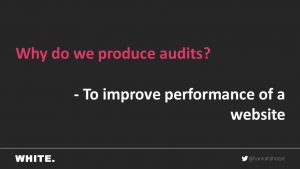
Sometimes thinking big isn’t enough
It’s great to have a think tank – a team of bright minds coming up with ideas to improve a business. But occasionally blue sky thinking just isn’t enough for reaching business goals. the biggest and best ideas may seem inspirational, but if they can’t get implemented, the value they add is very limited. So instead, let’s get practical.

Who actually wants to read an audit?
A technical audit isn’t exactly a best-selling novel. It’s simply a document to show how a website/business can improve the health of their site with actionable recommendations. Clients or business owners want to see results otherwise why would they invest in SEO? This, by definition, means they need actions.
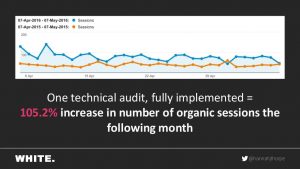
Why aren’t we implementing?
We all have excuses for not implementing. There’s no time; there are limited consequences, there is a limited resource, no motivation, there are conflicting views, a lack of understanding and an unexpected volume of work. But this is a rubbish excuse.

Stick to the audit rulebook
Instead, abide by the audit rulebook.
- Define the why
- Quantify everything
- Prioritise your tasks
- Show relationships
- Understand your stakeholders
- JFDI
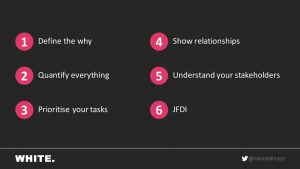
Step 1: Define the why
For every task, implementation and action from the audit, we need to explain why it’s being done – not just what will be happening. For example, say that you’re going to amend all broken links either by removing the link or replacing with a link to the relevant page, but also explain that this will improve the UX on site, and the way authority flows around the entire site. Then the second layer of ‘why’ is because this will then mean better ranking ability to generate organic traffic and more likelihood to convert users who have a good experience on site.
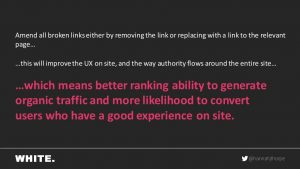
Step 2: Quantify everything
If long lists of tasks seem intimidating and difficult to relate to on a day-to-day basis then make sure to quantify everything. Creating a task sheet with an estimated timeframe for each task and their individual complexities will help the stakeholders understand the realistic estimation for the audit to be implemented.

Step 3: Prioritise tasks
One of the key aspects of planning audit implementations is prioritising the importance of each task. Just because there are some that’ll be easy to implement, this doesn’t mean they should be done first. If the longest task is the most important, this should be your first port of call.
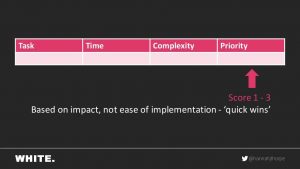
Step 4: Show relationships
Plan your implementation by individual tasks and milestone tasks. Milestones tasks are the point on a project timeline that signals the end of one part of the project and the start of the next. Within that milestone task, which may take a week, for example, are the individual tasks where there may be six within that week. Spreading these individual tasks out across the milestone timeframe will help break up the projects for more efficiency.

Step 5: Understand your stakeholders
Work out the persona of each stakeholder, understand what each brings to the table. Work out which personalities fit which tasks, and which job titles can work together to improve efficiency. Remember there are multiple personalities within a team. Often there are the playfuls, the powerfuls, the peacefuls and the precises. All will be different in how they work in a team; some better than others so it’s important everyone knows their roles before implementation.

Step 6: Just focus and do it (JFDI)
Don’t ask for forgiveness, ask for permission. Essentially, if you worry about what the bad outcome will be then nothing will get done. Just get on with it to the best your abilities. But what happens if it all goes wrong? Then instead of worrying about what has happened, ask yourself ‘why do you do it?’, ‘is there an alternative option?’, ‘how are you going to fix it?’. Be proactive rather than worrying.



